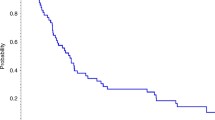Abstract
Patients (pts) with fulminant progression (FPG) of multiple myeloma (MM) after autologous stem cell transplantation (ASCT) have poor prognosis. Pancytopenia, extramedullary disease, and/or renal impairment are often present, and treatment options are limited. We have retrospectively evaluated 31 pts with FPG of MM after ASCT who were treated upfront salvage therapy with melphalan 100 mg/m2 (MEL 100) followed by PBSC support and consolidation therapy using regimens containing thalidomide (n = 16) or bortezomib (n = 15). The overall response rate (ORR) was 58% (18/31). After MEL 100, one patient achieved complete remission (3%), 26% of pts very good partial remission, 29% of pts partial remission, and 42% of pts stable disease. Progression within 3 months after MEL 100 occurred in 35% of pts. The median follow-up from MEL 100 was 8 months. The median TTP was 5 months (range, 2–15 months), and the median OS was 8 months (range, 3–23 months). There were no treatment-related deaths. In fulminant progression of MM, upfront MEL 100 is a safe salvage regimen with good response rate (ORR, 58%). Treatment with upfront MEL 100 followed by a thalidomide- or bortezomib-based regimen can prolong overall survival to more than 12 months in 33% of pts with fulminant progression of MM.


Similar content being viewed by others
References
Bruno B, Rotta M, Giaccone L et al (2004) New drugs for treatment of multiple myeloma. Lancet Oncol 5:430–432
Palumbo A, Avonto I, Bruno B et al (2006) Intravenous melphalan, thalidomide and prednisone in refractory and relapsed multiple myeloma. Eur J Haematol 76:273–277
Palumbo A, Ambrosini MT, Benevolo G et al (2007) Bortezomib, melphalan, prednisone and thalidomide for relapsed multiple myeloma. Blood 109:2767–2672
Zemanova M, Scudla V, Adam Z et al (2008) Low-dose thalidomide regimens in therapy of relapsed or refractory multiple myeloma. Neoplasma 55:345–349
Palumbo A, Avonto M, Bruno B et al (2006) Intermediate-dose melphalan (100 mg/m2)/bortezomib/thalidomide/dexamethasone and stem cell support in patients with refractory or relapsed myeloma. Clin Lymphoma Myeloma 6:475–477
Hajek R, Krejci M, Krivanova A et al (2007) Salvage treatment with melphalan 100 mg/m2 in fulminant progression of multiple myeloma. Haematologica 92(suppl):1, abstract 262
Durie B, Salmon S (1975) A clinical staging system for multiple myeloma. Cancer 36:842–854
Greipp PR, San Miguel J, Durie BG et al (2005) International staging system for multiple myeloma. J Clin Oncol 23:3412–3420
Blade J, Samson D, Reece D et al (1998) Criteria for evaluating disease response and progression in patients with multiple myeloma treated by high-dose therapy and haemopoietic stem cell transplantation. Myeloma Subcommittee of the EBMT. Br J Haematol 102:1115–1123
Durie BG, Harousseau JL, Miguel JS et al (2006) International uniform response criteria for multiple myeloma. Leukemia 20:1467–1473
Stewart AK, Bergsagel PL, Greipp PR et al (2007) A practical guide to defining high-risk myeloma for clinical trials, patients counseling and choice of therapy. Leukemia 21:529–534
Cancer Therapy Evaluation Program. Common terminology criteria for adverse event v 3.0 DCTD, NCI, NIH, DHHD, 2003. URL http://ctep.cancer.gov.
Lenhoff S, Hjorth M, Turesson I et al (2006) Intensive therapy for multiple myeloma in patients younger than 60 years. Long-term results focusing on the effect of the degree of response on survival and relapse pattern after transplantation. Haematologica 91:1228–1233
Palumbo A, Facon T, Sonneveld P et al (2008) Thalidomide for treatment of multiple myeloma: 10 years later. Blood 111:3968–3977
Davies FE, Wu P, Jenner M et al (2007) The combination of cyclophospshamide, velcade and dexamethasone induces high response rates with comparable toxicity to velcade alone and velcade plus dexamethasone. Haematologica 92:1149–1150
Garzia-Sanz R, Gonzalez-Porras JR, Hemandes JM et al (2004) The oral combination of thalidomide, cyclophosphamide and dexamethasone is effective in relapsed/refractory multiple myeloma. Leukemia 18:856–863
Kyriakou C, Thomson K, D´Sa S et al (2005) Low dose thalidomide in combination with oral weekly cyclophosphamide and pulsed dexamethasone is a well tolerated and effective regimen in patients with relapsed and refractory multiple myeloma. Br J Hematol 129:763–770
Roussou M, Anagnostopoulos A, Kastritis E et al (2007) Pulsed cyclophosphamide, thalidomide and dexamethasone regimen for previously treated patients with multiple myeloma: long term follow up and disease control after subsequent treatments. Leuk Lymphoma 48:754–758
San-Miguel JF, Richardson PG, Sonneveld P et al (2008) Efficacy and safety of bortezomib in patients with renal impairment: results from the APEX phase 3 study. Leukemia 22:842–849
Tosi P, Zamagni E, Cellini C et al (2004) Thalidomide alone or in combination with dexamethasone in patients with advanced, relapsed or refractory multiple myeloma and renal failure. Eur J Haematol 73:98–103
Acknowledgments
This study was supported by grants IGA NR/9225-3 and IGA NR/9317-3 from the Department of Health, Czech Republic.
Author information
Authors and Affiliations
Corresponding author
Rights and permissions
About this article
Cite this article
Krejci, M., Adam, Z., Buchler, T. et al. Salvage treatment with upfront melphalan 100 mg/m2 and consolidation with novel drugs for fulminant progression of multiple myeloma. Ann Hematol 89, 483–487 (2010). https://doi.org/10.1007/s00277-009-0862-z
Received:
Accepted:
Published:
Issue Date:
DOI: https://doi.org/10.1007/s00277-009-0862-z




